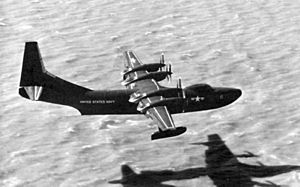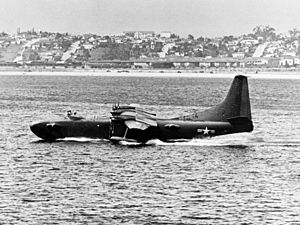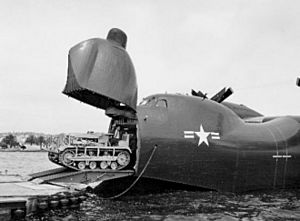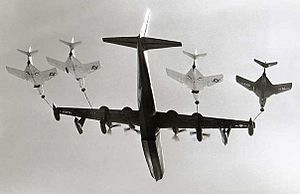Convair R3Y Tradewind facts for kids
Quick facts for kids R3Y Tradewind |
|
|---|---|
 |
|
| An R3Y-1 Tradewind low over San Francisco Bay near NAS Alameda | |
| Role | transport flying boat |
| Manufacturer | Convair |
| First flight | 22 February 1954 (R3Y-1) |
| Introduction | 1956 (R3Y-1) |
| Retired | 1958 |
| Status | Retired |
| Primary user | United States Navy |
| Number built | 11 (R3Y) & 2 (P5Y) |
The Convair R3Y Tradewind was a large flying boat aircraft from the 1950s. It was built in America by a company called Convair. It used special turboprop engines, which are like jet engines but they spin a propeller. This aircraft was mainly used by the United States Navy for transport and other jobs.
Contents
Designing a New Flying Boat
In 1945, the United States Navy asked Convair to design a big new flying boat. They wanted it to use new ideas from World War II, like special wings and powerful turboprop engines. Convair's design was called the Model 117.
This aircraft was a large flying boat with its wings placed high up. It had Allison T-40 engines that turned propellers with six blades. These propellers were special because they spun in opposite directions. The plane had a smooth body and small floats on its wings to keep it stable on water.
The Navy ordered two test planes in May 1946. These were named XP5Y-1. The first one flew for the first time on April 18, 1950, in San Diego. In August of that year, this plane set a record for turboprop aircraft by flying for 8 hours and 6 minutes without stopping.
From Patrol to Transport
At first, the Navy planned to use these planes for patrols. But they later decided to change the design. They wanted the plane to carry passengers and cargo instead.
One of the XP5Y-1 test planes had an accident in July 1953, but no one was hurt. Meanwhile, Convair kept working on the transport version. This new version was called the R3Y-1 Tradewind. It made its first flight on February 25, 1954.
The R3Y-1 had some big changes. All its weapons were removed. It also got a large door on the left side, about 10 feet (3.05 meters) wide, for loading things. The engine parts were also redesigned for better T40-A-10 engines. Inside, the cabin was made quieter and had air conditioning. It could carry 103 passengers or 24 tons of cargo. If used as an ambulance plane, it could carry 92 people on stretchers.
Different Versions of the Tradewind
In total, Convair built eleven of these aircraft. The first two were the P5Y test planes. They were armed with bombs, mines, torpedoes, and cannons.
The next five planes were built as R3Y-1 aircraft. These were used to carry troops and could even refuel other planes in the air.
The last six planes were the R3Y-2 version. These had a special nose that could open up, and the cockpit was placed higher. This design was meant to help them carry very heavy cargo and act like a "Flying LST" (a type of landing ship). However, it was very hard for pilots to keep the plane steady while loading or unloading on a beach. Because of this, the R3Y-2s were changed into tanker planes for inflight refuelling.
All the Tradewind planes had a short service life. This was because their Allison T40 turboprop engines were not reliable. Many planes that used the T40 engine had similar problems.
Tradewind in Service
In 1954, an R3Y Tradewind set a record for seaplanes. It flew across the country at 403 miles per hour (649 km/h) by using fast high-altitude winds. This record still stands today.
After testing, the planes were given to a US Navy transport squadron called VR-2 on March 31, 1956. But the problems with the engines and propellers continued. Because of these issues, the Navy stopped using the Tradewind planes. The squadron was closed down on April 16, 1958.
The six R3Y-2s that were converted into tankers could refuel four other planes at once. In September 1956, one of these planes successfully refueled four F9F Cougar fighter jets at the same time. This was a new achievement.
The entire program was stopped after thirteen aircraft were built. The main reason was the ongoing unreliability of the Allison T-40 turboprop engines. One of the XP5Y-1 test planes crashed due to a major engine failure. When the engine problems could not be fixed, the Navy stopped the program. Three more planes were lost because of engine failures. By 1958, the Navy gave up on the T-40 engine and all planes that used it. All P5Y and R3Y aircraft were grounded and later taken apart.
Images for kids





